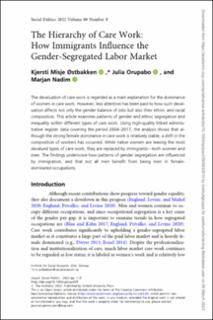| dc.contributor.author | Østbakken, Kjersti Misje | |
| dc.contributor.author | Orupabo, Julia | |
| dc.contributor.author | Nadim, Marjan | |
| dc.date.accessioned | 2023-03-16T07:47:35Z | |
| dc.date.available | 2023-03-16T07:47:35Z | |
| dc.date.created | 2022-11-18T14:56:27Z | |
| dc.date.issued | 2022 | |
| dc.identifier.issn | 1072-4745 | |
| dc.identifier.uri | https://hdl.handle.net/11250/3058591 | |
| dc.description.abstract | The devaluation of care work is regarded as a main explanation for the dominance of women in care work. However, less attention has been paid to how such devaluation affects not only the gender balance of jobs but also their ethnic and racial composition. This article examines patterns of gender and ethnic segregation and inequality within different types of care work. Using high-quality linked administrative register data covering the period 2004–2017, the analysis shows that although the strong female dominance in care work is relatively stable, a shift in the composition of workers has occurred. While native women are leaving the most devalued types of care work, they are replaced by immigrants—both women and men. The findings underscore how patterns of gender segregation are influenced by immigration, and that not all men benefit from being men in femaledominated occupations. | |
| dc.description.abstract | The Hierarchy of Care Work: How Immigrants Influence the Gender-Segregated Labor Market | |
| dc.language.iso | eng | |
| dc.title | The Hierarchy of Care Work: How Immigrants Influence the Gender-Segregated Labor Market | |
| dc.title.alternative | The Hierarchy of Care Work: How Immigrants Influence the Gender-Segregated Labor Market | |
| dc.type | Peer reviewed | |
| dc.type | Journal article | |
| dc.description.version | publishedVersion | |
| dc.source.journal | Social Politics: International Studies in Gender, State and Society | |
| dc.identifier.doi | 10.1093/sp/jxac039 | |
| dc.identifier.cristin | 2076521 | |
| cristin.ispublished | true | |
| cristin.fulltext | original | |
| cristin.qualitycode | 2 | |
